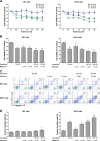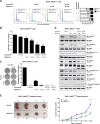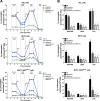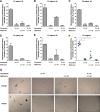Metformin exerts multitarget antileukemia activity in JAK2V617F-positive myeloproliferative neoplasms
- PMID: 29472557
- PMCID: PMC5833553
- DOI: 10.1038/s41419-017-0256-4
Metformin exerts multitarget antileukemia activity in JAK2V617F-positive myeloproliferative neoplasms
Abstract
The recurrent gain-of-function JAK2V617F mutation confers growth factor-independent proliferation for hematopoietic cells and is a major contributor to the pathogenesis of myeloproliferative neoplasms (MPN). The lack of complete response in most patients treated with the JAK1/2 inhibitor ruxolitinib indicates the need for identifying novel therapeutic strategies. Metformin is a biguanide that exerts selective antineoplastic activity in hematological malignancies. In the present study, we investigate and compare effects of metformin and ruxolitinib alone and in combination on cell signaling and cellular functions in JAK2V617F-positive cells. In JAK2V617F-expressing cell lines, metformin treatment significantly reduced cell viability, cell proliferation, clonogenicity, and cellular oxygen consumption and delayed cell cycle progression. Metformin reduced cyclin D1 expression and RB, STAT3, STAT5, ERK1/2 and p70S6K phosphorylation. Metformin plus ruxolitinib demonstrated more intense reduction of cell viability and induction of apoptosis compared to monotherapy. Notably, metformin reduced Ba/F3 JAK2V617F tumor burden and splenomegaly in Jak2V617F knock-in-induced MPN mice and spontaneous erythroid colony formation in primary cells from polycythemia vera patients. In conclusion, metformin exerts multitarget antileukemia activity in MPN: downregulation of JAK2/STAT signaling and mitochondrial activity. Our exploratory study establishes novel molecular mechanisms of metformin and ruxolitinib action and provides insights for development of alternative/complementary therapeutic strategies for MPN.
Conflict of interest statement
The authors declare that they have no conflict of interest.
Figures







Similar articles
-
Discovery and evaluation of ZT55, a novel highly-selective tyrosine kinase inhibitor of JAK2V617F against myeloproliferative neoplasms.J Exp Clin Cancer Res. 2019 Feb 4;38(1):49. doi: 10.1186/s13046-019-1062-x. J Exp Clin Cancer Res. 2019. PMID: 30717771 Free PMC article.
-
Ectopic PD-L1 expression in JAK2 (V617F) myeloproliferative neoplasm patients is mediated via increased activation of STAT3 and STAT5.Hum Cell. 2020 Oct;33(4):1099-1111. doi: 10.1007/s13577-020-00370-6. Epub 2020 Jul 14. Hum Cell. 2020. PMID: 32430672
-
NT157 has antineoplastic effects and inhibits IRS1/2 and STAT3/5 in JAK2V617F-positive myeloproliferative neoplasm cells.Signal Transduct Target Ther. 2020 Jan 24;5(1):5. doi: 10.1038/s41392-019-0102-5. Signal Transduct Target Ther. 2020. PMID: 32296029 Free PMC article.
-
[Analysis of oncogenic signaling pathway induced by a myeloproliferative neoplasm-associated Janus kinase 2 (JAK2) V617F mutant].Yakugaku Zasshi. 2012;132(11):1267-72. doi: 10.1248/yakushi.12-00225. Yakugaku Zasshi. 2012. PMID: 23123718 Review. Japanese.
-
The Development and Use of Janus Kinase 2 Inhibitors for the Treatment of Myeloproliferative Neoplasms.Hematol Oncol Clin North Am. 2017 Aug;31(4):613-626. doi: 10.1016/j.hoc.2017.04.002. Epub 2017 May 17. Hematol Oncol Clin North Am. 2017. PMID: 28673391 Review.
Cited by
-
Inhibition of ERK1/2 signaling prevents bone marrow fibrosis by reducing osteopontin plasma levels in a myelofibrosis mouse model.Leukemia. 2023 May;37(5):1068-1079. doi: 10.1038/s41375-023-01867-3. Epub 2023 Mar 16. Leukemia. 2023. PMID: 36928007 Free PMC article.
-
Mitochondrial metabolism sustains DNMT3A-R882-mutant clonal haematopoiesis.Nature. 2025 Jun;642(8067):431-441. doi: 10.1038/s41586-025-08980-6. Epub 2025 Apr 16. Nature. 2025. PMID: 40239706 Free PMC article.
-
Targeting Abnormal Hematopoietic Stem Cells in Chronic Myeloid Leukemia and Philadelphia Chromosome-Negative Classical Myeloproliferative Neoplasms.Int J Mol Sci. 2021 Jan 11;22(2):659. doi: 10.3390/ijms22020659. Int J Mol Sci. 2021. PMID: 33440869 Free PMC article. Review.
-
Discovering Potential in Non-Cancer Medications: A Promising Breakthrough for Multiple Myeloma Patients.Cancers (Basel). 2024 Jun 28;16(13):2381. doi: 10.3390/cancers16132381. Cancers (Basel). 2024. PMID: 39001443 Free PMC article. Review.
-
Metformin use and risk of myeloproliferative neoplasms: a Danish population-based case-control study.Blood Adv. 2024 Aug 27;8(16):4478-4485. doi: 10.1182/bloodadvances.2023012266. Blood Adv. 2024. PMID: 38758071 Free PMC article.
References
Publication types
MeSH terms
Substances
Grants and funding
LinkOut - more resources
Full Text Sources
Other Literature Sources
Research Materials
Miscellaneous

